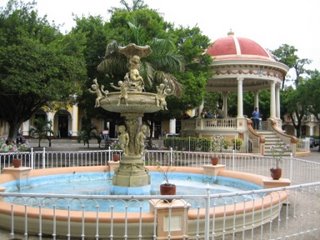Granada
“Ni la misma Granada de Espana is tan Linda y extrana como esta de aqui”
- Tino Lopez Guerra (1940)
After staying out till 4am on Friday night, I woke at 11:30 Saturday morning a bit groggy, but
 thanks to a bucket of cold water (the tap water wasn’t running) and some gallo pinto (rice and beans), I was ready to do some exploring. In the short time I’ve been here I’ve learned that Managua is a fun place at night. It has the best movie theaters, restaurants, bars and dance clubs in the whole country. However, during the day Managua is a hot ugly city with not much to do. So after consulting with my guide book, I decided to spend Saturday afternoon in the colonial town of Granada.
thanks to a bucket of cold water (the tap water wasn’t running) and some gallo pinto (rice and beans), I was ready to do some exploring. In the short time I’ve been here I’ve learned that Managua is a fun place at night. It has the best movie theaters, restaurants, bars and dance clubs in the whole country. However, during the day Managua is a hot ugly city with not much to do. So after consulting with my guide book, I decided to spend Saturday afternoon in the colonial town of Granada.I took a “Microbus” or van from Managua to Granada. The drive was about an hour including numerous stops to pick up or drop people off en route. I’ve learned that there really don’t seem to be direct buses here in Nicaragua. If there are empty seats, the bus will stop to pick up
 anyone who flags it down. And the ticket taker will scream the name of the buses destination to anyone standing on the side of the road in hopes of drumming up business.
anyone who flags it down. And the ticket taker will scream the name of the buses destination to anyone standing on the side of the road in hopes of drumming up business.But back to Granada. It really is a beautiful city. Granada is on the western end of Lake Nicaragua (more commonly known here as Lago Cocibolca), and most guidebooks say that it’s the most beautiful colonial town in Nicaragua. It was founded by Spanish settlers in the 16th century, and was the seat of power for William Walker, an American who briefly ruled Nicaragua in the mid-19th century. When he was forced to flee Granada in 1856 he burned the city to the ground, and most buildings today date from the late 1800s when the city rebuilt after the devastation left by William Walker.
Granada is not so different from colonial towns I’ve seen in other parts of Latin America (San
 Cristobal, Mexio; Antigua, Guatemala; Trinidad, Cuba; Cuenca, Equador). But after being in Managua for the past two weeks, Granada’s brightly painted houses with sloping tile roofs seemed like architectural paradise to me. I spent a couple hours just wandering around the cobblestone streets, visiting the many churches and taking pictures of houses that caught my attention. I went to the museum in the old convent of San Francisco. The convent dates back to the 16th century, although it was destroyed a few times by fires and earthquakes, and so the present building is only about 150 years old. Inside the museum was an interesting exhibit of pre-Columbian stone statues as well as a display of art by contemporary Nicaraguan painters.
Cristobal, Mexio; Antigua, Guatemala; Trinidad, Cuba; Cuenca, Equador). But after being in Managua for the past two weeks, Granada’s brightly painted houses with sloping tile roofs seemed like architectural paradise to me. I spent a couple hours just wandering around the cobblestone streets, visiting the many churches and taking pictures of houses that caught my attention. I went to the museum in the old convent of San Francisco. The convent dates back to the 16th century, although it was destroyed a few times by fires and earthquakes, and so the present building is only about 150 years old. Inside the museum was an interesting exhibit of pre-Columbian stone statues as well as a display of art by contemporary Nicaraguan painters. 

0 Comments:
Post a Comment
<< Home